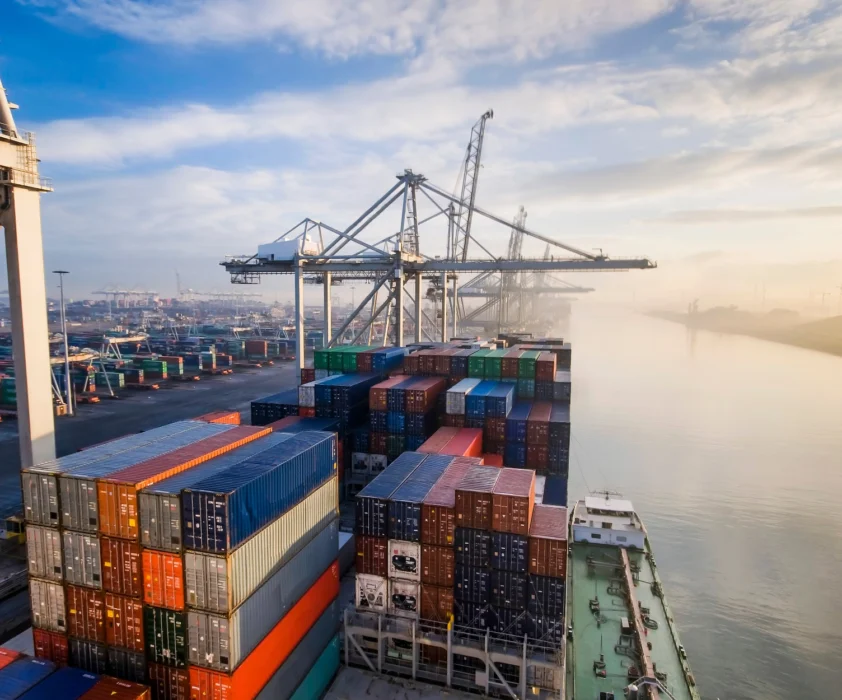
According to the American Association of Port Authorities, water transportation generates $5.4 trillion in economic activity annually and is responsible for 31 million American jobs. As such, anything that impacts the flow of raw commodities or containerized goods can have cascading impacts further down the supply chain and are often unforeseen (as demonstrated during the pandemic).
To maintain the competitiveness of U.S. ports and infrastructure, the U.S. Department of Transportation Maritime Administration (MARAD) has secured $450 million in annual federal funding for the Port Infrastructure Development Program (PIDP). This program focuses on modernizing the nation’s coastal and inland waterways, ensuring the U.S. can handle dynamic supply chain challenges so that cargo and raw goods can get where they need to be, no matter what.
With industrial and logistics facilities needed to support increased shipping activity, commercial real estate (CRE) within these regions is seeing an uptick in demand.
Case in point: the Port of Long Beach, Port of Virginia, and Port of Savannah.
Port of Long Beach: The Port of Choice
The Port of Long Beach, one of the busiest container ports in the United States, is undergoing ambitious expansion projects to accommodate larger vessels and boost capacity. With more than $52 million invested in infrastructure upgrades, including constructing new terminals and deepening harbor channels, the Port of Long Beach is positioning itself as a premier gateway for international trade. As a result, there is a growing need for warehousing and distribution centers in the surrounding area to handle the influx of goods flowing through the port.
“Port activity is a major driver of the Southern California industrial market,” says Jared Dienstag, Director of Research for Stream SoCal. “It is a key reason why so many companies maintain an industrial presence in the region.”
Dienstag explains that in Los Angeles County, industrial rents are highest in the South Bay submarket due to its proximity to the Long Beach and Los Angeles ports. “Average annual asking rents in the South Bay submarket are $21.60 per square foot, compared to $19.92 for the entire Los Angeles market, highlighting the premium cost of being near the port,” he adds.
With transportation and logistics being major challenges for industrial occupiers, proximity to the port is a major appeal. “The quicker products are loaded on and off at the port, the quicker they can reach their destination and eventually be sold to consumers,” says Dienstag. “The most recent grant for the Port of Long Beach will accelerate cargo flow, further benefiting companies throughout the area.”
Dienstag notes that except for 2021 and 2022, when the impact of COVID-19 was most significant in supply chain logistics, 2024 could potentially set a TEU record at the Port of Long Beach based on year-to-date data from January to April.
The Port of Virginia: America’s Most Modern Gateway
Similarly, the Port of Virginia, encompassing facilities in Norfolk, Portsmouth, and Newport News, is undergoing a transformational expansion initiative to enhance its capacity and efficiency. With investments totaling $1.4 billion, the Port of Virginia is upgrading terminals, expanding rail and road networks, and deploying cutting-edge technology to streamline operations. This expansion is driving the need for industrial real estate in the region, with developers scrambling to meet the growing need for warehouse and distribution space near the port.
“Port activity is a major driver of economic growth and opportunity in the region served by the Port of Virginia,” comments Charlie Smiroldo, Managing Director for Stream D.C. “The port’s strategic location on the East Coast makes it a crucial gateway for international trade, attracting businesses and investment to the surrounding areas.”
As a vital link in the global supply chain, the Port of Virginia’s ongoing expansion initiatives enhance its capacity to handle increased cargo volumes, creating opportunities for businesses to capitalize on the growing need for logistics and distribution services. Smiroldo highlights that the improved infrastructure projects have made The Port of Virginia the only semi-automated port, allowing for two-way vessel traffic while also being the deepest along the East Coast. “This allows for additional TEUs and reduced turnaround time for trucks,” he explains.
Consequently, industrial real estate markets near the Port of Virginia are experiencing heightened demand, driving up property values and spurring development activity.
“Because land supply is constrained in areas surrounding the port, mainly due to wetlands and limited tolerance for re-zoning, many companies are branching into regions historically outside their search areas, yet still close enough to provide the port access they need,” says Smiroldo. “Areas along I-64 and I-95, in and around Richmond, have been the beneficiaries—it’s amazing to see what’s happening across the region directly related to port users.”
Smiroldo continues, “The Port has been an exceptional partner, too, often assisting developers with the jurisdictional process and connecting companies to warehouse and yard space. It’s rare and encouraging for future growth to find an organization that’s great to work and also a full advocate.”
The Port of Savannah: The Single Largest and Fastest Growing Terminal in the U.S.
Strategically located along the Savannah River in Georgia, the Port of Savannah has become one of the fastest-growing and most vital ports in the U.S.
Owned and operated by the Georgia Ports Authority (GPA), this bustling port is experiencing continued remarkable growth, as the GPA is committed to over $4.5B in investment centered around infrastructure improvements to both the Port of Savannah and intermodal connectivity. Announced in 4Q 2023, the Blue Ridge Connector project will be designed to serve as an inline connector between Gainesville and the Port of Savannah, facilitating the movement of rail traffic off the port into Northeast Georgia and beyond.
“GPA’s commitment to innovation and sustainability continues to drive the Port of Savannah’s growth,” says Andrew Ashmore, Senior Associate for Stream Atlanta. “By investing heavily to streamline operations, reduce environmental impact, and improve overall efficiency, they are establishing themselves as the primary gateway to the Southeast.”
This growth has bolstered the local economy and contributed significantly to the broader economic landscape, creating thousands of jobs and attracting substantial investment to the region. “In May 2024, the Port of Savannah handled 490,000 TEUs–a 22% increase from May 2023, with several months throughout 2022 reaching the low to mid-500,000 TEU range,” notes Ashmore.
Looking to the future, Ashmore anticipates continued growth, especially as electric vehicle manufacturing expands throughout the Southeastern U.S. “These infrastructure advancements are expected to increase the Port of Savannah’s capacity from 7 million TEUs annually to more than 12 million within the next decade.”
Opportunities abound
As the U.S. continues to invest in ports, infrastructure, and critical manufacturing, the resulting demand for industrial spaces, such as warehouses, distribution centers, and manufacturing facilities, is likely to lead to higher property values, new development projects, and increased economic activity. Strengthening the nation’s infrastructure is not only enhancing global trade capabilities but also creating numerous opportunities for growth and investment in the real estate market. CRE stands poised to reap significant rewards.
—
Jared Dienstag is the Director of Research for Stream’s Southwest Region, overseeing office, industrial, and retail market research across Southern California.
Charlie Smiroldo is the Managing Director for Stream’s Washington, D.C. office, responsible for tenant representation, investment sales, construction management, and acquisitions. He also leads Stream’s Industrial Development Services in the Mid-Atlantic region.
Andrew Ashmore is a Senior Associate for Stream Atlanta, specializing in research and representation services for the industrial sector.


